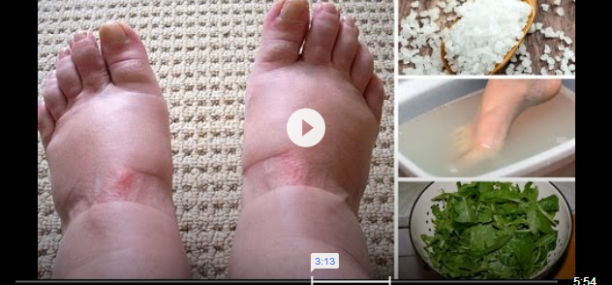How to treat peripheral edema at home?
Continuous swelling in one or both feet may indicate a real problem; however, in most cases, the reason for this is the pressure caused by the weight. In this case peripheral edema occurs due to unhealthy lifestyle and bad diet. The edema may also result from accumulation of fluid (fluid retention), tissue inflammation, or joint disease. Consult with your doctor if problem persists.
21 scientifically proven ways to treat peripheral edema at home
1- Follow a low-salt diet and reduce your intake of salty foods. Avoid pickles, soy sauce, fried foods, white flour and white sugar. Follow diet number 7 and limit your salt intake to less than 3 grams per day. A salt free diet can help reduce swelling, especially if your water retention is the result of a high-salt diet.
2- Rest, raise your legs above your heart while lying down by putting them on pillows and sit with your feet up as often as you can.
3- Get fit and lose weight if necessary
4- Exercise your legs by walking. Take a short walk every hour.
5- Wear support stockings and avoid wearing high heels to work
6- Drink at least eight glasses of water daily
7- Avoid tobacco, caffeine, alcohol and energy drinks
8- Have a healthy diet and try herbal remedies
9- Try to massage the swollen body part(s)
10- Eat anti-inflammatory vegetables like tomatoes, olive oil, green leafy vegetables (including kale, spinach and collards), and nuts like almonds and walnuts.
11- Include plenty of fatty fish like salmon, mackerel, tuna, and sardines in your diet
12- Eat fruits like blueberries, cherries, strawberries, and oranges.
13- Take diuretic pills or water pills, like furosemide
14- If you are taking calcium channel blockers, reducing the dose of your medicine will usually help
15- Avoid lean meat, beef, chocolate, dairy products, dried shellfish, gravies, and olives, if you have swelling in the legs and feet.
16- Add 2 teaspoons of apple cider vinegar to a glass of water, and drink it twice daily. ACV helps reverse fluid retention as it is high in potassium.
17- Increase your intake of potassium-rich foods, such as bananas (1 medium banana contains 422 mg of potassium), pomegranate, avocado (1 whole avocado contains 690 mg of potassium), spinach, salmon (3 ounces of salmon contain 416 mg of potassium), dried apricots, raisins (quarter cup contains 250 mg of potassium), coconut water, oranges, winter squash (1 cup of cooked acorn or butternut squash contains 896 mg of potassium), broccoli (1 cup of cooked broccoli contains 458 mg of potassium), lentils (half cup of cooked lentils contain 366 mg of potassium), potato (one medium baked potato contains 610 m of potassium), fat free yogurt (1 cup of fat free yogurt contains 579 mg of potassium), lima beans (1 cup of cooked lima beans contain 955 mg of potassium), white beans (half cup of canned white beans contain 595 mg of potassium), sweet potato (one medium baked sweet potato with skin contains 694 mg of potassium), and low fat milk (there are 366 mg of potassium in 8 ounces of 1% low fat). Alternatively take a potassium supplement. The recommended daily potassium intake for adults is 4,000 mg. Potassium helps to restore balanced fluid levels in the body.
18- Try hydrotherapy, fill two plastic foot soaking tubs (foot basins) with water, one with warm water and the other with cold water. Soak your feet in the warm water for three minutes, then immediately put your feet in the cold water for about 1 minute. Repeat this 15 times. The hot water helps improve circulation as it allows the blood vessels to dilate (vasodilation), whereas, the cold water can reduce and prevent pooling of fluids in the feet and ankles, as it causes the blood vessels to contract (vasoconstriction).
19- Fill one foot tub (foot soaking bowl) with warm water, add two tablespoons of salt and stir, soak feet in it for 15-20 minutes, wash your feet with lukewarm water and soap, use a towel to dry your feet and legs, then mix a few drops of jojoba oil with a few drops of grapefruit oil (an anti-inflammatory agent), a few drops of ginger oil, and a few drops of peppermint oil (antimicrobial sedative agent), and massage your feet with the oils to reduce swelling and improve circulation..
20- Put a handful of malva sylvestris in a large pot, add two liters of water over the herb and bring it to a boil, fill a foot tub with this warm solution, and soak feet in it for 15-20 minutes, wash your feet with lukewarm water and soap. Repeat twice daily.
21- Take a rutin supplement
[aio_button align=”center” animation=”flash” color=”red” size=”medium” icon=”none” text=”let us know which way works best for you” relationship=”dofollow” url=”https://medcoi.com/auth/question/how-to-treat-or-relieve-peripheral-edema/”]
Verified by: Dr.Diab (March 5, 2018)
Citation: Dr.Diab. (March 5, 2018). How to treat peripheral edema at home?. Medcoi Journal of Medicine, 5(2). urn:medcoi:article20224.














There are no comments yet
Or use one of these social networks